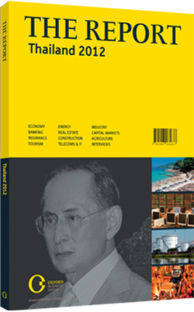Big C Supercenter: Retail
THE COMPANY: Big C Supercenter, the second-largest hypermarket in terms of number of stores in Thailand after Tesco Lotus, was founded in 1993. The major shareholders are Géant International BV, which is part of the Casino Group – a well-known retailer based in France that has investments in retail businesses in many countries – and the Chirathivat Group. Big C offers a variety of goods at competitive prices across a range of modern retail outlets, which as of the end of 2011 comprised 108 hypermarkets (48 in Bangkok and Greater Bangkok and 60 upcountry), 12 Big C Markets, 51 Mini Big Cs and 50 Pure shops selling health care and beauty products.
The products that are available at Big C can be divided into five main categories: fresh food (9.4%), dry food (53.5%), electrical appliances (16.3%), clothing and accessories (10.9%), and home décor and accessories (9.9%). Big C also provides rental space at its Big C centres in the Big C Town Centre. Vendors selling goods that are different to what is already sold at Big C can rent space in the Big C Town Centre. The idea is to give customers a wider range of products and services in a single location, which is in line with Big C’s goal of providing its customers with a one-stop shopping experience. The operators renting space in the Big C Town Centre fall into four primary categories: food and beverage, entertainment, specialty stores and services.
DEVELOPMENT STRATEGY: Big C has a multi-faceted business strategy, which helps to drive it ahead in the Thai marketplace and contributes to its growth. The strategy includes broadening its customer base, ensuring a fun and convenient shopping experience for the whole family, and offering low prices as well as a large choice of products.
Big C had 1731 private label stock-keeping units as of the end of 2011, which contributed 2.9% to sales value and 5.9% to sales volume. Value-added services will help boost Big C’s consumer loyalty, and the company is currently engaged in maximising the efficiency of its logistics systems as well as its charity, the Big C Foundation.
In what was a transformational year for Big C, 2011 saw the company successfully take over Carrefour in Thailand and all of its 43 supermarkets were fully integrated into Big C’s systems by July that year. Capturing of synergies was completed two years ahead of the original timeframe and BT1.7bn ($54.23m) of run-rate EBITDA level synergies were captured during 2011 compared to the initial target of BT1.2bn ($38.28m) by 2013. This resulted in significant improvements to Big C’s margins: its gross margin was up 161 bp, recurring EBITDA rose by 151 bp and recurring EBIT surged 192 bp. In addition to the supermarkets it acquired from Carrefour, it continued its expansion programme, establishing a further three hypermarkets, two Big C Markets, 37 Mini Big Cs and 21 Pure stores throughout 2011.
As the number-two player in the market, Big C continues to extend its reach across multiple formats, concentrating on Big C Markets and Mini Big Cs. It has set very aggressive expansion targets for over the next five years, and aims to increase the number of hypermarkets and Big C Markets to 300, from 120 as of 2011. It also plans to boost the number of Mini Big Cs from 51 stores to 950 in 2016.
To support this plan, a new distribution centre will be opened in 2013 and is expected to be cost-neutral by this time because of efficiency programmes. Big C will take advantage of new business opportunities offered by online shopping technology. Big C will continue boosting private label sales via the introduction of the Casino brand, and will further develop its leading dual retail-property model. Customer loyalty will be strengthened through the Big Card loyalty programme. The programme’s member base has grown rapidly, from 1.7m card holders in 2008 to 6.5m card holders in 2011. Member sales have risen from 20% in 2009 to 63% in 2011, while member basket size is almost double that of non-members.
You have reached the limit of premium articles you can view for free.
Choose from the options below to purchase print or digital editions of our Reports. You can also purchase a website subscription giving you unlimited access to all of our Reports online for 12 months.
If you have already purchased this Report or have a website subscription, please login to continue.

